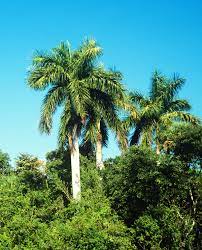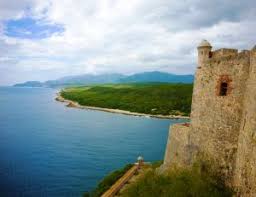LA PALMA REAL, LA REINA DE LOS CAMPOS DE CUBA. UNA DE LAS MAS BELLAS DEL MUNDO. PHOTOS
EL primer árbol que contempla quien visita Cuba es la Palma Real. Resulta difícil pensar en nuestra isla sin su presencia. A lo largo del país desde el Cabo San Antonio, su extremo más occidental, hasta el más oriental, la punta de Maisí, se van viendo palmas en grupos o aisladas en todo paisaje e incluso alineadas a ambos lados de las carreteras. Pienso que esa imagen es imborrable para todos los cubanos.
LA PALMA REAL, Nombre científico o latino: Roystonea regia. Origen: Cuba.
Nombre común o vulgar: Palmera real, Chaguaramo cubano, Palmera real cubana, Asahí, Caruta, Chaguarama, Mapora, Palma de yaguar, Palmiche, Palmiste, Yagua, Yaguarrama. Familia: Arecaceae (antes Palmaceae).
La Palmera real de Cuba tiene un tronco robusto, tipo columna, de color blanco mármol, un tallo de la corona enorme, color verde césped, y una hermosa corona de hojas grandes y plumosas. Es de crecimiento rápido en condiciones favorables.
Sus hojas pinnadas de hasta 8 metros de largo y color verde brillante por ambas caras, tienen un aspecto airoso y plumoso, sus folíolos pueden llegar a medir hasta un metro sobre todo los de la base de la hoja.
Entre la zona de unión de tronco y capitel brotan las inflorescencias que son muy ramificadas, con pequeñas flores aromáticas de color blanco. Frutos redondeados de color púrpura. Estos frutos ricos en grasas y almidón son dados a los cerdos como un excelente pienso.
Una de las palmeras más bellas del Mundo. No por gusto es nuestro árbol nacional y aparece en el escudo de la república.
LA REINA DE LOS CAMPOS DE CUBA
Reconocida como la reina de los campos por su majestuosidad y belleza, además de la utilidad que reporta, la Palma Real es el más numeroso de los árboles del país.
Cuando los colonizadores llegaron a esta nación en el siglo XV, los aborígenes vivían en bohíos, chozas de tablas de palmas, techo de guano y paredes de yagua, estructura que se expandió por todo el campo cubano. Y todos estos componentes provienen de nuestra palma. Todavía este tipo de vivienda puede verse disperso en los lugares más intrincados y abruptos del territorio donde muchos de nuestros campesinos aún viven en bohíos, especialmente en las zonas montañosas.
Según el reconocido científico cubano Juan Tomás Roig y Mesa, se suponía que sólo existía una especie de Palma Real en Cuba, pero estudiosos minuciosos de las palmas cubanas demostraron que son varias las especies y variedades de palmas reales.
La región oriental de la Isla de Cuba, con cinco especies del género, es el centro de origen, y es el centro de evolución de dicho género, cuyas diez especies viven naturalmente sólo en las Antillas y en territorio de América del Norte, América Central y América del Sur, que resultan más o menos cercanos a estas islas, distribución geográfica que refleja su origen antillano.
Muchas localidades del archipiélago cubano han eliminado grandes cantidades de poblaciones de Palma Real a favor de planes de desarrollo agrícola y para la urbanización de zonas rurales. No obstante, si se atraviesa la Isla de un lado a otro, todavía pueden verse innumerables palmares a ambos lados de la carretera.
Y estoy seguro que la palma siempre estará allí…
Muy utilizada en alineaciones por su porte en calles o avenidas.
Es una de las palmeras más bellas del Mundo.
LA PALMA REAL, THE QUEEN OF THE FIELDS OF CUBA. ONE OF THE MOST BEAUTIFUL IN THE WORLD. PHOTOS
The first tree that anyone who visits Cuba sees is the Royal Palm. It is difficult to think of our island without their presence. Throughout the country from Cabo San Antonio, its westernmost end, to its easternmost, Maisí point, palms are seen in groups or isolated throughout the landscape and even lined up on both sides of the roads. I think that this image is indelible for all Cubans.
LA PALMA REAL, Scientific or Latin name: Roystonea regia. Origin: Cuba.
Common or vulgar name: Royal Palm, Cuban Chaguaramo, Cuban Royal Palm, Asahí, Caruta, Chaguarama, Mapora, Yaguar Palm, Palmiche, Palmiste, Yagua, Yaguarrama. Family: Arecaceae (formerly Palmaceae).
The Royal Cuban Palm has a sturdy, column-like, marble-white trunk, a huge crown stem, grass green, and a beautiful crown of large, feathery leaves. It is fast-growing under favorable conditions.
Its pinnate leaves up to 8 meters long and bright green on both sides have an airy and feathery appearance, its leaflets can measure up to one meter, especially those at the base of the leaf.
Inflorescences that are highly branched, with small aromatic white flowers, sprout between the trunk and capital junction area. Rounded purple fruits. These fruits rich in fat and starch are given to pigs as excellent feed.
One of the most beautiful palm trees in the world. Not for pleasure, it is our national tree and it appears on the coat of arms of the republic.
THE QUEEN OF THE FIELDS OF CUBA
Recognized as the queen of the fields for its majesty and beauty, in addition to the usefulness it brings, the Royal Palm is the most numerous of the country’s trees.
When the colonizers arrived in this nation in the 15th century, the aborigines lived in huts, palm-plank huts, guano roofs, and yagua walls, a structure that spread throughout the Cuban countryside. And all these components come from our palm. Still, this type of housing can be seen scattered in the most intricate and abrupt places of the territory where many of our farmers still live in huts, especially in the mountainous areas.
According to the renowned Cuban scientist Juan Tomás Roig y Mesa, it was assumed that only one species of Royal Palm existed in Cuba, but meticulous scholars of Cuban palms have shown that there are several species and varieties of royal palms.
The eastern region of the Island of Cuba, with five species of the genus, is the center of origin and is the center of evolution of the said genus, whose ten species live naturally only in the Antilles and in the territory of North America, Central America and South America, which are more or less close to these islands, a geographic distribution that reflects their Antillean origin.
Many towns in the Cuban archipelago have eliminated large numbers of populations from Palma Real in favor of agricultural development plans and for the urbanization of rural areas. However, if you cross the Island from one side to the other, you can still see countless palm groves on both sides of the road.
And I’m sure the palm will always be there …
Widely used in alignments due to its bearing on streets or avenues.
It is one of the most beautiful palm trees in the world.
Agencies/ MemoriasCubanas/ Derubin Jacome/ Extractos/ Excerpts/ Internet Photos/ Arnoldo Varona/ www.TheCubanHistory.com
THE CUBAN HISTORY, HOLLYWOOD.



 LA PALMA REAL , la Reina de los Campos de Cuba. Una de las Más Bellas del Mundo. PHOTOS. * LA PALMA REAL, The Queen of the Fields of Cuba. One of the Most Beautiful in the World. PHOTOS
LA PALMA REAL , la Reina de los Campos de Cuba. Una de las Más Bellas del Mundo. PHOTOS. * LA PALMA REAL, The Queen of the Fields of Cuba. One of the Most Beautiful in the World. PHOTOS





